Smoothies - US - November 2005 Executive ... - Catering.com.co
Smoothies - US - November 2005 Executive ... - Catering.com.co
Smoothies - US - November 2005 Executive ... - Catering.com.co
Create successful ePaper yourself
Turn your PDF publications into a flip-book with our unique Google optimized e-Paper software.
<strong>Smoothies</strong> - <strong>US</strong> - <strong>November</strong> <strong>2005</strong><strong>Executive</strong> Summary$1.6 billion market fuelled by <strong>co</strong>nsumer demand for quick, healthy foodIn response to the well-publicized childhood and adult obesity epidemics in the U.S,demand for healthy, <strong>co</strong>nvenient products has grown significantly in the last several years.At least some Americans are trying to eat healthier, though doing so can be challenginggiven that an increasing portion of meals and snacks are eaten away from home—atwork, school, in the car, etc. More <strong>co</strong>nsumers are seeking alternatives to soda and oftengreasy, fattening, fast food fare, and this trend has been a boon for sales of smoothies,which enjoy a positive, healthy image and can be easily <strong>co</strong>nsumed on the go. <strong>Smoothies</strong>ales also received a boost from the new <strong>2005</strong> U.S. Dietary guidelines, which re<strong><strong>co</strong>m</strong>mendeating one and a half to two cups of fruit per day to help maintain a healthy weight andprevent ailments including heart disease, cancer and high blood pressure. Smoothiemanufacturers are leveraging these re<strong><strong>co</strong>m</strong>mendations by positioning their products as aquick, easy way to get the re<strong><strong>co</strong>m</strong>mended daily servings of fruit and vegetables.Made-to-order segment driving market growthMade-to-order smoothies—prepared on-site at smoothie bars, health clubs, restaurants—ac<strong>co</strong>unt for 94% of total smoothie sales. This segment is driving category growth throughproduct innovation aimed to increase usage occasions and bring in new users (e.g.breakfast smoothies, hot drinks, and expanded food menus), <strong><strong>co</strong>m</strong>bined with strong newstore growth. The rapid expansion of national and regional smoothie chains andindependents—<strong>co</strong>upled with the growing presence of smoothies as a menu item at quickservice<strong>co</strong>unters and restaurants—helped increase total U.S. sales of made-to-ordersmoothies by about 38% from 2003-05.Packaged smoothies ac<strong>co</strong>unt for less than 6% of category sales. RTD sales increased 14%from 2003-05, <strong>co</strong>nsiderably less than made-to-order smoothies. It is likely that packagedsmoothies were harder hit by the low-carb trend than the made-to-order segment. Due tolonger product development times, the RTD segment was slower to react to changing diettrends and the introduction of reduced carb products. In addition, despite productimprovements, taste remains a barrier to drinking RTD smoothies for many <strong>co</strong>nsumers,who do not believe that a bottled smoothie can taste as good as the “real thing” and, ifgiven a choice between a made-to-order and a bottled smoothie, will choose the former.This report is supplied in ac<strong>co</strong>rdance with Mintel's terms and <strong>co</strong>nditions.© Mintel International Group Limited.
Non-traditional marketing still most <strong><strong>co</strong>m</strong>monMade-to-order smoothie shops do very little traditional advertising (TV and print),instead relying on marketing tactics aimed to drive product trials and build loyalty. Themost <strong><strong>co</strong>m</strong>mon promotional activities employed are sampling, <strong>co</strong>upons, sweepstakes, andloyalty cards entitling customers to a free smoothie after a designated number ofpurchases. Most smoothie shops are franchised, and their payment agreement usuallyprovides for an advertising and promotion budget. The franchisee will agree to pay 4% ofits annual sales on marketing efforts to help grow its business, and in exchange the<strong><strong>co</strong>m</strong>pany will provide materials (e.g. print, radio spots, TV ads, direct mail, promotionalmaterials, etc.) for the franchisee's use.Traditional advertising vehicles are more likely to be used in the packaged smoothiesegment, where large <strong><strong>co</strong>m</strong>panies such as Unilever (Slim-Fast Optima), and Campbell’s(V8 Splash) have substantial advertising budgets and typically support new productlaunches with TV, print, radio and freestanding inserts (FSIs). However, total advertisingspending within the smoothie market is low <strong><strong>co</strong>m</strong>pared to other categories, in part becausemany of the suppliers are smaller <strong><strong>co</strong>m</strong>panies, like Fuze and Bolthouse Farms, which tendto rely more heavily on grass-roots marketing tactics, such as sampling tours and eventsponsorship, to generate awareness.The smoothie <strong>co</strong>nsumerAs the number of outlets selling smoothies has multiplied, smoothie <strong>co</strong>nsumption hasgrown significantly: 43% of respondents to Mintel’s exclusive <strong>co</strong>nsumer survey aged 18+reported drinking some type of smoothie in the past month.Smoothie <strong>co</strong>nsumption is heavily skewed toward younger <strong>co</strong>nsumers: nearly two thirds(63%) of 18-24-year-old respondents claimed to have had a smoothie in the last month<strong><strong>co</strong>m</strong>pared to only a third (33%) of those aged 55-64. Incidence of <strong>co</strong>nsumption declinessteadily with age, which is most likely due to the availability of smoothies—for example,smoothie shops are <strong><strong>co</strong>m</strong>monplace on <strong>co</strong>llege campuses, making them more accessible toyounger <strong>co</strong>nsumers—and different eating habits. Younger people are more likely to bebalancing school, work and other activities, and as a result are frequently eating on thego.The incidence of smoothie drinking is higher among women than men—47% of womendrink smoothies <strong><strong>co</strong>m</strong>pared to 39% of men. This is probably because women tend to bemore health- and weight-<strong>co</strong>nscious, and therefore a good match for the smoothie“lifestyle.”This report is supplied in ac<strong>co</strong>rdance with Mintel's terms and <strong>co</strong>nditions.© Mintel International Group Limited.
On average, smoothie <strong>co</strong>nsumers interviewed drink about three smoothies per month.The key reasons respondents choose to drink smoothies, aside from taste, are refreshment(31%) and health benefits (27%). The primary usage barriers for made-to-ordersmoothies are availability (in other words, there are no stores selling smoothies nearby)and price. Usage barriers for bottled, RTD smoothies are similar to those of fresh, madeto-ordersmoothies, with price and availability issues topping the list. Taste <strong>co</strong>ncernswere more of an issue with bottled smoothies, with nearly one in five respondents (whohad not drunk a smoothie in the past month) saying that they do not like the taste ofbottled smoothies.The future of smoothiesThe major <strong>co</strong>nsumer trends that have fueled growth in the smoothies market— healthiereating and <strong>co</strong>nsuming more meals on the go—are expected to <strong>co</strong>ntinue, which shouldhelp further category growth. In addition, the high rate of product innovation that hascharacterized the market in both the made-to-order and RTD segments in the last severalyears is expected to <strong>co</strong>ntinue, with more products targeted to Baby Boomers and weight<strong>co</strong>nscious<strong>co</strong>nsumers in the pipeline.The made-to-order segment will <strong>co</strong>ntinue to attract new <strong>co</strong>nsumers by adding newlocations and moving into less-developed territories like airports and hospitals. At thesame time, the expansion of smoothie shop menus to include healthy foods (e.g. wraps,soups, and salads) is expected to attract <strong>co</strong>nsumers looking for a bite to eat with theirsmoothie and may help increase visit frequency.Mintel forecasts that sales of smoothies will rise from $1,593 million in <strong>2005</strong> to $2,652 in2010, or growth of 66% at current prices and 42% at <strong>co</strong>nstant prices with an inflationadjustedCAGR (<strong><strong>co</strong>m</strong>pound annual growth rate) of 7.2%. U.S. sales of made-to-ordersmoothies are predicted to increase 65% at current prices and to increase 40% at <strong>co</strong>nstantprices from <strong>2005</strong> to 2010. On the other hand, packaged smoothies are predicted toincrease 92% at current prices and to increase 63% at <strong>co</strong>nstant prices from <strong>2005</strong> to 2010.Much of this growth is a function of lower market share <strong><strong>co</strong>m</strong>pared to made-to-ordersmoothies as well as intense new product development and <strong><strong>co</strong>m</strong>petition by drinksmanufacturers, which is likely to <strong>co</strong>ntinue into the foreseeable future.This report is supplied in ac<strong>co</strong>rdance with Mintel's terms and <strong>co</strong>nditions.© Mintel International Group Limited.
<strong>Smoothies</strong> - <strong>US</strong> - <strong>November</strong> <strong>2005</strong>Market DriversThe Market Drivers section identifies the principal external factors that affect the<strong>Smoothies</strong> market. These factors may have either a positive or negative influence.Americans trying to lead healthier lifestylesObesity and related health issues such as diabetes have increased at an alarming rate inthe U.S. during the past 20 years as Americans lead more sedentary lifestyles, <strong>co</strong>nsumelarger portions, and eat more processed foods. As a <strong>co</strong>nsequence of these and other socioe<strong>co</strong>nomicfactors, nearly two thirds of adults in the U.S. are overweight, and 31% are<strong>co</strong>nsidered obese (Source: Centers for Disease Control and Prevention).Even more alarming is the dramatic increase in overweight children: approximately 15%of children aged 6-11 are <strong>co</strong>nsidered overweight. The good news is that media attentionon the obesity and overweight epidemic has heightened <strong>co</strong>nsumer awareness of the linkbetween diet and obesity. Ac<strong>co</strong>rding to Mintel’s Eating Habits—U.S., July 2004, twothirds of <strong>co</strong>nsumers surveyed say that they are “trying to eat healthier food these days.”The healthy eating trend has helped boost sales of smoothies, which have enjoyed ahealthy, nutritious image since they first became popular in California in the 1970s.Having said this, it is important to note that obesity rates in the U.S. are still risingamongst not only children, but also adults. It is possible that smoothies are viewed bysome as a <strong>co</strong>nvenient way of trying to be healthy. In other words, you can be overweight,have a bad diet, yet salve your <strong>co</strong>nscience by having a smoothie now and again and say toyourself, ‘I ate/drank healthily this time.’ It also means that if your doctor has said‘increase fruit/vegetable intake’ you can do this with one smoothie, and not have to worryabout the rest of the day’s diet. This can play into the hands of those who want toimprove their diet with minimal effort.Shift from low-carb to balanced approach to eatingThe low-carb diet trend was at the height of its popularity in 2004, as millions ofAmericans monitored their carbohydrate intake and cut back on carb-laden foods likebread and cereal in an effort to manage their weight. Ac<strong>co</strong>rding to Mintel’s Low Carb—U.S., May 2004 report, 7% of adult respondents reported that they were on a low-carbdiet as of February 2004, and an additional 33% were “carb-aware”—they were notofficially on a low-carb diet such as Atkins or South Beach, but had cut back on sugarand carbs.This report is supplied in ac<strong>co</strong>rdance with Mintel's terms and <strong>co</strong>nditions.© Mintel International Group Limited.
When projected to the U.S. adult population as a whole, an estimated 83.6 million adultswere either on a low-carb diet or had reduced their carbohydrates. This trend hurt sales ofsmoothies, which are fruit- and juice-based, and therefore can <strong>co</strong>ntain significant levelsof sugar and carbohydrates. (An “Original” size Banana Berry smoothie from JambaJuice <strong>co</strong>ntains 112g of carbs and 99g of sugar.) To defend themselves, nearly all of themajor smoothie chains and RTD manufacturers launched reduced carb versions of theirproducts during 2003 and 2004.While the number of <strong>co</strong>nsumers following low-carb diets has dropped steeply in <strong>2005</strong>,the impact of the trend <strong>co</strong>ntinues to be felt in the form of increased <strong>co</strong>nsumer awarenessof carbohydrates. There has been a shift from “low-carb” to “right carbs”— that is, fruits,vegetables, and whole grains—which were advocated by the popular South Beach Diet,as well as the new United States Department of Agriculture (<strong>US</strong>DA) Dietary Guidelines.The new guidelines, which were rolled out in April <strong>2005</strong>, re<strong><strong>co</strong>m</strong>mend eating one and ahalf to two cups of fruit per day to help maintain a healthy weight and prevent heartdisease, cancer, and high blood pressure. This advice presents an excellent opportunityfor smoothie <strong><strong>co</strong>m</strong>panies to position their products as a quick, easy way to get there<strong><strong>co</strong>m</strong>mended daily servings of fruit and vegetables. Jamba Juice cites the DietaryGuidelines on its website and touts the three to four servings of fruit per (Original size)smoothie, while new RTD Tropicana Fruit <strong>Smoothies</strong> claim “two and a half servings offruit” on their packaging.Smoothie manufacturers have responded to the obesity epidemic and Americans’ desireto eat healthier with an array of new products targeted to weight-<strong>co</strong>nscious <strong>co</strong>nsumers. In2003, in response to customers’ <strong>co</strong>ncerns about “super-sizing,” Jamba Juice introduced asmaller, 16oz smoothie (versus the 24oz Original size), and in 2004 launched a line of“Enlightened <strong>Smoothies</strong>,” which are made with Splenda and <strong>co</strong>ntain a third less caloriesand about half the sugar of its regular smoothies.Freshëns <strong>Smoothies</strong> now offers a line of low-calorie smoothies (which replaced thechain’s low-carb line), Smoothie King offers a Slim-N-Trim line, and Planet Smoothiehas a line of “Weight Loss” <strong>Smoothies</strong> with a “fat burner blast.” In the packagedsmoothie segment, the majority of reduced calorie and reduced sugar introductions havebeen in the yogurt drink category, including Stonyfield Farm’s Light <strong>Smoothies</strong>, YoplaitNouriche, Light; Dannon Light ‘n Fit <strong>Smoothies</strong>. There were few weight-<strong>co</strong>nsciousproducts launched in the packaged fruit smoothie segment, though Slim-Fast added afruit smoothie to its Optima line of high-protein, reduced sugar products.Health club membership on the riseIn addition to eating healthier, Americans are be<strong><strong>co</strong>m</strong>ing more active, evidenced by theclimb in health club membership over the last several years.This report is supplied in ac<strong>co</strong>rdance with Mintel's terms and <strong>co</strong>nditions.© Mintel International Group Limited.
The following Figure displays trends in health club membership and the number of healthclubs during the period 2000-04.Figure 1: U.S. health club and membership growth, 2000-042000 2001 2002 2003 2004 Change2000-04000 000 000 000 000 %Number ofhealth clubmembersNumber ofhealth clubs32,800 33,700 36,300 39,400 41,300 25.916.9 17.8 20.2 23.5 26.8 58.6SOURCE: International Health, Racquet, & Sportsclub Association/MintelHealth club memberships increased 26% from 2000-04, reaching 41.3 million membersin 2004. This trend has helped drive sales of smoothies, in part because people who workout tend to eat healthier, but also because many gyms now offer juice/smoothie bars as ameans to boost revenues and provide a value-added service for members.Health clubs are an ideal venue for smoothie sales—the <strong>co</strong>re smoothie <strong>co</strong>nsumer ishealth-<strong>co</strong>nscious and active, which fits the profile for fitness club members. Juice andsmoothie bars are typically found only in higher workout volume clubs. Bally TotalFitness Holdings, the largest <strong><strong>co</strong>m</strong>mercial operator of fitness centers in North America, interms of sales, operates about 418 gyms under the Bally’s, Pinnacle, and Gorilla Sportsnames. Bally’s has juice/smoothie bars in about 182 of those locations, and has beenrepositioning many of its in-club retail stores by replacing slower-moving fashion apparelwith juice/smoothie bars.Growing demand for healthy fast foodAmericans are working longer hours and leading increasingly busy lives, which has led tothe decline of the traditional, sit-down meal. This means that more and more meals are<strong>co</strong>nsumed on the go—in the car, on the train, and at work or school. Almost half of<strong>co</strong>nsumers say that most of their eating occasions take place away from home, ac<strong>co</strong>rdingto research referenced in a January <strong>2005</strong> Brand Packaging article. For <strong>co</strong>nsumers tryingto eat healthier, eating on the go can present a challenge, as many foods found at<strong>co</strong>nvenience stores and fast food restaurants are lacking in nutrients and high in fat andcalories.This report is supplied in ac<strong>co</strong>rdance with Mintel's terms and <strong>co</strong>nditions.© Mintel International Group Limited.
Many time-pressed, health-minded <strong>co</strong>nsumers are finding that smoothies are a goodsolution. Made with fresh fruit and packed with nutrients, smoothies enjoy a healthyimage and can be easily <strong>co</strong>nsumed on the run. Many <strong>co</strong>nsumers are using smoothies as ameal replacement, typically for breakfast, and to a lesser extent, for lunch. At the sametime, to help drive morning sales, many smoothie chains are adding breakfast items totheir menus. Planet Smoothie, a 138-unit chain, introduced five new breakfast offeringsin <strong>2005</strong>, among them an Acai Energy Bowl, made with Acai, banana, apple juice, andgranola, as well as a Honey Oats Smoothie, which is <strong><strong>co</strong>m</strong>prised of a blend of cinnamon,oatmeal, honey and fruit.Last year Jamba Juice launched a line of Yogurt Blends smoothies geared for breakfast,followed in <strong>2005</strong> by a line of <strong>co</strong>ffee alternatives for <strong>co</strong>nsumers who do not want <strong>co</strong>ffee,but need a burst of energy to get them going in the morning. Jamba’s Energy <strong>Smoothies</strong>line includes: Matcha Green Tea Blast, a blend of green tea, soymilk, frozen yogurt andsorbet; Acai Supercharger, made with Acai juice, guarana, soymilk, raspberry sherbet,strawberries, blueberries and ice; and Turbo Tropic, a blend of mangoes, strawberries,peaches, orange and pineapple sherbet, pineapple juice, kiwi juice, ice and an EnergyBoost. These smoothies <strong>co</strong>ntain 15-75mg of caffeine per Original size serving.In addition to offering breakfast items, some smoothie chains are offering extensive foodmenus targeted at <strong>co</strong>nsumers seeking healthy food along with their drinks. Two chainsdoing so are Planet Smoothie and Tropical Smoothie. In 2004 Planet Smoothie opened itsfirst Planet Smoothie Café, offering light sandwiches, wraps, paninis, salads and achildren’s menu, in addition to a smoothie bar. There are currently seven Planet SmoothieCafés in operation. Tropical Smoothie Café, a 130-store chain based in Florida, offersgourmet wraps, sandwiches, tortizzas, salads, bagels and <strong>co</strong>ffee.Exotic flavors are hotAs Americans be<strong><strong>co</strong>m</strong>e more aware of ethnic and foreign cuisines, they are looking to trynew, unique flavors to add some variety to their diets. Many smoothie chains have addedexotic fruit flavors and ingredients to their menus to attract variety seekers. One of thehottest new ingredients is Acai, an antioxidant-rich berry that grows wild in the BrazilianAmazon. Another emerging ingredient is green tea—in March <strong>2005</strong> Jamba introduced aMatcha Green Tea Blast smoothie made with green tea, soymilk, frozen yogurt andsorbet.Smoothie King, the third-largest smoothie chain in the U.S., leveraged <strong>co</strong>nsumers’longing for unique, new flavors by launching a “<strong>Smoothies</strong> around the World” linefeaturing exotic ingredients including Acai, green tea, passion fruit, goji (a sweet, redberry that is a good source of antioxidants, minerals, and amino acids), and mangosteen(a purple, apple-size fruit that <strong>co</strong>ntains high levels of xanthones, a powerful antioxidant).This report is supplied in ac<strong>co</strong>rdance with Mintel's terms and <strong>co</strong>nditions.© Mintel International Group Limited.
While ready-to-drink smoothie manufacturers have been slower to pick up the trend, weare starting to see more tropical fruit flavors in the packaged segment, particularlymango. Odwalla, Silk Live!, Sambazon, and Wholesoy all offer mango-flavored RTDsmoothies. Two other up-and-<strong><strong>co</strong>m</strong>ing fruits popular in other beverage segments—cranberry and pomegranate—will likely start to pop up in the smoothie category.Increased <strong><strong>co</strong>m</strong>petition from other drinksThe packaged smoothies market faces strong <strong><strong>co</strong>m</strong>petition from an abundance of newbeverage products on the market. The two greatest threats are yogurt drinks and dairydrinks.Yogurt drinksDrinkable yogurt is a rapidly growing segment, sales of which have outpaced those ofpackaged smoothies in recent years. From 2003-05, sales of yogurt drinks increased77%—from $256 to $452 million—while sales of other (non-yogurt-based) ready-todrinksmoothies grew only 14%. This strong growth has been fueled by growing<strong>co</strong>nsumer awareness of the health benefits of yogurt, <strong><strong>co</strong>m</strong>bined with a high level ofproduct innovation in the segment.Dannon, the current leader in the drinkable yogurt market with a 65% market share,expanded its line-up with Danactive probiotic dairy drinks, Danimals XL (essentiallyDanimals in a bigger bottle for older kids), and Light n’ Fit Carb Control. Yoplait, theleading maker of yogurt, introduced a line of Yoplait and Yoplait Light smoothies thatpromise “the Yoplait you love, now in a delicious smoothie.”Several brands introduced lower-calorie or low-carb varieties targeted to weight<strong>co</strong>nscious<strong>co</strong>nsumers, including Yoplait’s Nouriche Light, Stonyfield Farm’s Light<strong>Smoothies</strong>, and Hood’s Carb <strong>co</strong>untdown (which carry the Atkins Approved symbol).Organic <strong><strong>co</strong>m</strong>petitor Horizon Organic Dairy launched a line of organic smoothies thisyear, while White Wave launched a line of Silk “Live!” drinks made with live culturesand Silk soymilk. Several of these new product launches, including Yoplait and SilkLive! smoothies, were supported with significant advertising campaigns, which likelyhelped boost awareness for the category.Flavored milk & milkshakesThe ready-to-drink flavored milk and milkshake segments have also grown steadily inrecent years, with sales increasing approximately 250% since 1999. Though they aretypically targeted to kids, milk drinks may be stealing share from smoothies, as they<strong><strong>co</strong>m</strong>pete in the larger nutritious beverage arena.This report is supplied in ac<strong>co</strong>rdance with Mintel's terms and <strong>co</strong>nditions.© Mintel International Group Limited.
Like the drinkable yogurt category, the flavored milk/milkshake market has recently seenan explosion of new products. In August <strong>2005</strong>, PepsiCo launched Quaker Milk Chillersmade with 2% reduced fat milk and sweetened with natural and no-calorie sweeteners,including Splenda. The product claims it <strong>co</strong>ntains 45-50% less sugar than leadingflavored milks. Also Hershey’s has extended its line of bottled milkshakes with new‘indulgent’ flavors by introducing new products made with Whoppers and YorkPeppermint Pattie candies. And, lastly, in 2004 Nestlé launched a line of Nesquik low-fatmilkshakes with flavors like vanilla caramel and s’mores.Aging populationThe average age of the U.S. population is increasing as the large Baby Boomergeneration grows older. The industry will need to be more successful at attracting olderadults, but at least the highest-<strong>co</strong>nsuming age group (15-34) will expand more quickly in<strong>2005</strong>-10 than it did in 2000-05.The Figure below details shifts in the U.S. age structure during 2000-10.Figure 2: U.S. population, by age, 2000-102000 <strong>2005</strong> 2010 2000-10Age % % % % change
The large Baby Boomer group, which en<strong><strong>co</strong>m</strong>passes over 75 million people born in theperiod 1946-64, is growing older, with the oldest members about to enter their sixties.Overall, the U.S. population is growing older: during the years <strong>2005</strong>-10, <strong>co</strong>nsumers aged45-74 will grow at a much quicker pace than younger groups.The fastest-growing group will be 55-64-year-olds, which is expected to increase over19% in the next five years. This will present a challenge for smoothie <strong><strong>co</strong>m</strong>panies, assmoothie <strong>co</strong>nsumption declines <strong>co</strong>nsiderably with age.Ac<strong>co</strong>rding to Mintel’s exclusive <strong>co</strong>nsumer survey, only one in three <strong>co</strong>nsumers aged 55-64 reported drinking smoothies in the past month <strong><strong>co</strong>m</strong>pared to approximately two in threeof those aged 18-24. This is because over-55s do not eat on the go as much as theiryounger <strong>co</strong>unterparts, and prefer to eat whole or sliced fresh fruit instead. Another majorreason for this trend is that this older generation grew up at a time when smoothies werenot as popular. They are also less likely to explore new drink or food types. At the sametime it is likely that the current generation, who have been swept along with the wave ofsmoothie popularity, will <strong>co</strong>ntinue to drink them well into their old age.On the positive side, aging Baby Boomers are more active than their parents were at theirage, and they tend to believe that they can actively manage health issues through diet andexercise. This presents an opportunity for smoothie manufacturers to develop productsthat address the health <strong>co</strong>ncerns of this group, namely high cholesterol, blood pressure,and weight management.Manufacturers have taken advantage of this by launching a host of Baby Boomer-targetedproducts that offer relevant benefits such as low cholesterol and added fiber. Forexample, Cargill recently debuted a low-calorie, heart-healthy smoothie made withPectin—a product known as a good source of fiber—and Corowise plant sterols, whichare shown to help lower cholesterol.A factor that was slightly negative in 2000-05 for the smoothie market, but is shiftingmore positively, lies with those aged 15-34. In 2000-05, this broad group grew by 2.4million, or 3.0%, but will expand by 3.1 million, or 3.5%, during <strong>2005</strong>-10. This age rangeis by far most likely to drink smoothies, at roughly 60%, relative to the 35-54s at 42%and older adults at <strong>co</strong>nsiderably lower levels (see The Consumer section).Growing awareness of organicSales of organic foods grew about 20% per year from 1997-2003, from $3.5 billion to$10.3 billion, ac<strong>co</strong>rding to the Organic Trade Association. In <strong><strong>co</strong>m</strong>parison, total U.S. foodsales grew only 2-4% per year. Driven by <strong>co</strong>ncerns about food safety and a trend towardshealthier eating, <strong>co</strong>nsumers are increasingly seeking out organic options.This report is supplied in ac<strong>co</strong>rdance with Mintel's terms and <strong>co</strong>nditions.© Mintel International Group Limited.
Ac<strong>co</strong>rding to Mintel’s Organic Food and Beverage—U.S., August 2004, 41% of<strong>co</strong>nsumers reported buying organic foods or beverages in the past year, up from 34% in2002. Indeed, organic foods are be<strong><strong>co</strong>m</strong>ing increasingly mainstream—traditionalsupermarkets, mass merchandisers and club stores ac<strong>co</strong>unted for about 44% of organicfood sales in 2003.The growing popularity of organic has spawned the introduction of dozens of organicpackaged smoothies, including Stonyfield Farm and Horizon Organic yogurt smoothies;Sambazon juice smoothies; Lifeway Foods Soytreat, made with active probiotic kefircultures and soybeans; and Wholesoy cultured soy smoothies.While most organic smoothies are distributed primarily through the natural foodschannel, Stonyfield Farm enjoys wide distribution in mainstream channels and has shownstrong growth: since their introduction in 2002, Stonyfield Farm’s Organic <strong>Smoothies</strong>have grown into a $25 million brand in FDM.This report is supplied in ac<strong>co</strong>rdance with Mintel's terms and <strong>co</strong>nditions.© Mintel International Group Limited.
<strong>Smoothies</strong> - <strong>US</strong> - <strong>November</strong> <strong>2005</strong>Future & ForecastFuture trendsAvailability of smoothies increased dramatically in the last several years as smoothieshave gained distribution in a wide range of locations ranging from health clubs to airportsto golf <strong>co</strong>urses. Increased points of sale have helped drive strong penetration gains:ac<strong>co</strong>rding to Mintel’s <strong>co</strong>nsumer survey, 43% of respondents aged 18+ claimed to havehad some type of smoothie in the past month. The healthier eating trend and <strong>co</strong>nsumerdemand for healthy alternatives to fast food will <strong>co</strong>ntinue to drive growth of thesmoothies market. However, the pace of future growth will also depend on <strong>co</strong>ntinueddistribution gains, as well as new marketing programs and products designed to increase<strong>co</strong>nsumption frequency.Smoothie chains <strong>co</strong>ntinue push to expand, entering new territoryThe drive to add new smoothie locations does not appear to be slowing down, evidencedby the aggressive expansion plans of the major chains. Perhaps due to saturation intypical locations such as shopping centers and malls, some <strong><strong>co</strong>m</strong>panies are venturing intonon-traditional locations. For example, market leader Jamba Juice plans to open 80-100more stores in 2006 and aims to open its first <strong><strong>co</strong>m</strong>pany-owned and -operated stores inairports. Freshëns averages 120-140 new stores per year, and has plans to expand withinthe healthcare sector.Healthy eating and <strong>co</strong>nvenience trends <strong>co</strong>ntinue to foster growthAs discussed in the Market Drivers section of this report, the healthier eating trend—<strong><strong>co</strong>m</strong>bined with increased incidence of eating on the go—helped drive growth in thesmoothie market during the review period. Both trends are expected to <strong>co</strong>ntinue, andsmoothie sales should receive an additional boost from the latest version of the DietaryGuidelines for Americans and food pyramid, released in January <strong>2005</strong>. The newguidelines re<strong><strong>co</strong>m</strong>mend higher intake of fruits, vegetables, and low-fat dairy products, allof which can be found in the quick and <strong>co</strong>nvenient form of a smoothie. Expect to seemore smoothie <strong><strong>co</strong>m</strong>panies leveraging their strong nutritional <strong>co</strong>ntent, as Jamba Juice hasdone on its website, touting the servings of three to six pieces of fruit in every serving.This report is supplied in ac<strong>co</strong>rdance with Mintel's terms and <strong>co</strong>nditions.© Mintel International Group Limited.
In response to obesity trends and the resulting healthier eating trend, made-to-order andRTD smoothie <strong><strong>co</strong>m</strong>panies have launched numerous reduced calorie and “light” versionsof their products targeted to weight-<strong>co</strong>nscious individuals. Mintel expects to see<strong>co</strong>ntinued growth in the light segment, as these new products draw in <strong>co</strong>nsumers whoonce avoided smoothies due to <strong>co</strong>ncerns about calorie and sugar <strong>co</strong>ntent.Smoothie chains <strong>co</strong>ntinue to adopt new profit channelsAs mentioned in the Market Size and Trends section, smoothie chains have been adding avariety of new types of smoothies. Many of these products have been targeted to increasebreakfast sales with new product additions introduced by smoothie <strong><strong>co</strong>m</strong>panies such asJamba Juice and Planet Smoothie.Planet Smoothie has introduced its Acai Energy Bowl and has opened its PlanetSmoothie Cafés that sell light sandwiches, paninis, wraps and salads while Jamba Juicesells ‘yogurt blends,’ ‘<strong>co</strong>ffee alternative’ drinks specifically targeted for the breakfastmarket, juices and baked goods (such as bread and pretzels) and hot products includinghot green and red teas <strong><strong>co</strong>m</strong>bined with exotic fruits. As can be seen, many of theseproducts are not typical smoothie products.These business model changes are likely to <strong>co</strong>ntinue as smoothie chains diversify theirproducts in the hope of increasing sales. Smoothie chains are increasingly adopting this‘Starbucks-type’ business model, whereby they are expanding the variety of their <strong>co</strong>reproduct offerings while at the same time adding products that are not necessarilyassociated with smoothies. However, if they stick to their <strong>co</strong>re <strong><strong>co</strong>m</strong>petencies of offeringfresh, healthy and nutritious products, they are likely to succeed and increase revenues.Expanded food menus will bring in new customersA number of smoothie shops are adding fresh and/or packaged healthy food items to theirmenus targeted to <strong>co</strong>nsumers looking for a healthy bite to eat to ac<strong><strong>co</strong>m</strong>pany theirsmoothie. The two largest chains, Jamba Juice and Smoothie King, have traditionallyoffered a limited selection of snack-type items like pretzels, breadsticks, <strong>co</strong>okies, andenergy bars for <strong>co</strong>nsumers looking to add a little something to make it a meal.This report is supplied in ac<strong>co</strong>rdance with Mintel's terms and <strong>co</strong>nditions.© Mintel International Group Limited.
Other chains have taken advantage of the <strong>co</strong>nsumer demand for healthy alternatives tofast food—and the lack of options currently available in much of the <strong>co</strong>untry outside ofthe West Coast—and have begun offering healthy, on-the-go food items. For instance,Tropical Smoothie Café, a 130-store chain based in Florida, began offering gourmetwraps, sandwiches, tortizzas, salads, bagels and <strong>co</strong>ffee in 2000. Another growing chain,Planet Smoothie, launched its Planet Smoothie Café <strong>co</strong>ncept in 2004 in Orlando, Florida,offering light sandwiches, wraps, paninis, salads and a children's menu, in addition to asmoothie bar. Adding food items helps draw in new <strong>co</strong>nsumers, which should in turn givesmoothie sales a boost.More Baby Boomer-targeted productsThe aging of the Baby Boomer generation presents a challenge for smoothie makers.Over-55s are less likely than younger <strong>co</strong>nsumers to drink smoothies, mainly because theydo not eat as many meals or snacks on the go. Also, as mentioned before, this age groupdid not grow up around smoothies and are more <strong>co</strong>nservative in trying new or differenttypes of food and drink products. In order to attract mature <strong>co</strong>nsumers to the category,smoothie makers will need to offer specific benefits relevant to this age group, such asheart health, weight management and added fiber themes. Cargill recently introduced alow-calorie, heart-healthy smoothie made with Pectin—a product known as a goodsource of fiber—and Corowise plant sterols, which are shown to help lower cholesterol.Mintel expects to see more smoothie products developed with Baby Boomers in mind.Market ForecastMintel used SPSS statistical software to forecast the market trend to 2010. Themethodology <strong>co</strong>rrelates historical market size data with significant e<strong>co</strong>nomic anddemographic determinants including in<strong><strong>co</strong>m</strong>e and population. Those factors having themost influence on the market are used to produce the market size forecast.<strong>Smoothies</strong>Total U.S. sales of smoothies are forecast to increase at an inflation-adjusted annual rateof 7.2% through 2010.The following Figure shows Mintel’s forecast of sales of smoothies.This report is supplied in ac<strong>co</strong>rdance with Mintel's terms and <strong>co</strong>nditions.© Mintel International Group Limited.
Figure 34: Forecast of total U.S. sales of smoothies, at current and <strong>co</strong>nstantprices, <strong>2005</strong>-2010YearSales atcurrentpricesSales at<strong>co</strong>nstant<strong>2005</strong>prices*$million Index % change $million Index % change<strong>2005</strong> (est.) 1,593.4 100 - 1,593.4 100 -2006 1,785.9 112 12.1 1,732.2 109 8.72007 1,987.6 125 11.3 1,868.1 117 7.82008 2,198.8 138 10.6 2,000.5 126 7.12009 2,420.0 152 10.1 2,129.4 134 6.42010 2,651.5 166 9.6 2,256.4 142 6.0Note: Excludes Wal-Mart sales* Adjusted for inflation using the All Items CPISOURCE: MintelThe following Figure shows Mintel’s forecast of sales of smoothies graphically.Graph: Figure 35: Forecast of total U.S. sales of smoothies, at current and<strong>co</strong>nstant prices, <strong>2005</strong>-2010Note: Excludes Wal-Mart sales* Adjusted for inflation using the All Items CPISOURCE: MintelTotal U.S. sales of smoothies are predicted to increase 66% at current prices and toincrease 42% at <strong>co</strong>nstant prices from <strong>2005</strong> to 2010. By <strong><strong>co</strong>m</strong>parison, from 2000 to <strong>2005</strong>,total U.S. sales of smoothies increased by 70% at current prices and increased 50% at<strong>co</strong>nstant <strong>2005</strong> prices.Made-to-order smoothiesU.S. sales of made-to-order smoothies are forecast to increase at an inflation-adjustedannual rate of 7.0% through 2010.This report is supplied in ac<strong>co</strong>rdance with Mintel's terms and <strong>co</strong>nditions.© Mintel International Group Limited.
The following figure shows Mintel’s forecast of sales of made-to-order smoothies.Figure 36: Forecast of U.S. sales of made-to-order smoothies, at current and<strong>co</strong>nstant prices, <strong>2005</strong>-2010YearSales atcurrentpricesSales at<strong>co</strong>nstant<strong>2005</strong>prices*$million Index % change $million Index % change<strong>2005</strong> (est.) 1,502.8 100 - 1,502.8 100 -2006 1,678.6 112 11.7 1,628.1 108 8.32007 1,863.6 124 11.0 1,751.5 117 7.62008 2,058.2 137 10.4 1,872.6 125 6.92009 2,262.9 151 9.9 1,991.2 132 6.32010 2,477.8 165 9.5 2,108.6 140 5.9* Adjusted for inflation using the All Items CPISOURCE: MintelU.S. sales of made-to-order smoothies are predicted to increase 65% at current prices andto increase 40% at <strong>co</strong>nstant prices from <strong>2005</strong> to 2010. By <strong><strong>co</strong>m</strong>parison, from 2000 to<strong>2005</strong>, U.S. sales of made-to-order smoothies increased by 64% at current prices andincreased 45% at <strong>co</strong>nstant <strong>2005</strong> prices.Packaged smoothiesU.S. FDM sales of packaged smoothies are forecast to increase at an inflation-adjustedannual rate of 10.3% through 2010.The following figure shows Mintel’s forecast of sales of packaged smoothies.Figure 37: Forecast of U.S. FDM sales of packaged smoothies, at current and<strong>co</strong>nstant prices, <strong>2005</strong>-2010YearSales atcurrentpricesSales at<strong>co</strong>nstant<strong>2005</strong>prices*$million Index % change $million Index % changeThis report is supplied in ac<strong>co</strong>rdance with Mintel's terms and <strong>co</strong>nditions.© Mintel International Group Limited.
<strong>2005</strong> (est.) 90.6 100 - 90.6 100 -2006 107.3 118 18.4 104.1 115 14.92007 124.0 137 15.6 116.5 129 12.02008 140.6 155 13.4 127.9 141 9.82009 157.1 173 11.7 138.2 153 8.12010 173.7 192 10.6 147.8 163 6.9Note: Excludes Wal-Mart sales* Adjusted for inflation using the All Items CPISOURCE: MintelU.S. FDM sales of packaged smoothies are predicted to increase 92% at current pricesand to increase 63% at <strong>co</strong>nstant prices from <strong>2005</strong> to 2010. By <strong><strong>co</strong>m</strong>parison, from 2000 to<strong>2005</strong>, U.S. FDM sales of packaged smoothies increased by 289% at current prices andincreased 244% at <strong>co</strong>nstant <strong>2005</strong> prices.Forecast FactorsThe forecast for U.S. sales of smoothies will be affected by changes in the followingfactors:-Health factors: Consumers’ eagerness to <strong>co</strong>nsume products that are perceived as healthyis expected to <strong>co</strong>ntinue to drive the smoothies market. Although, not all smoothies arelow in calories or fat, <strong>co</strong>nsumers are expected to <strong>co</strong>ntinue to choose smoothies as ahealthier or more natural alternative to other fast-food choices. If there were significantchanges in <strong>co</strong>nsumer <strong>co</strong>ncerns about healthy eating over the forecast period, it would beexpected that actual future sales of smoothies would differ from the forecast amount. Ahigher awareness by <strong>co</strong>nsumers over the next five years of the link between diet andhealth would be expected to boost smoothies sales beyond the forecast amount.-Product innovation: Innovations in the smoothies market <strong>co</strong>uld potentially stimulatefuture sales beyond the forecast level. Possible innovations include products thatintroduce exciting and exotic flavors, boost or enhance smoothies by adding new,beneficial nutrients, or introduce greater <strong>co</strong>nvenience in packaging. If the rate ofinnovation and new product introduction exceeds the projected rate, future sales ofsmoothies would be expected to exceed the forecast.-This report is supplied in ac<strong>co</strong>rdance with Mintel's terms and <strong>co</strong>nditions.© Mintel International Group Limited.
Marketing and advertising: Smoothie retailers typically eschew traditional mediaadvertising in preference to personal marketing such as sampling and loyalty cards. If themade-to-order smoothie retailers adopt a more aggressive marketing and advertisingstrategy, including greater reliance on TV and print advertising it is possible that<strong>co</strong>nsumer demand would be stimulated and future sales would exceed the forecast. Theincreased marketing activity would <strong><strong>co</strong>m</strong>e at a <strong>co</strong>st to the retailers and would only beundertaken if their calculus of the benefits outweighs the <strong>co</strong>sts.-Expansion of retail outlets: The expected <strong>co</strong>ntinued growth of the smoothies marketover the next five years is linked to an expectation of <strong>co</strong>ntinued growth in retail outletsfor smoothies. <strong>Smoothies</strong> can now be purchased at bars, restaurants, and health clubs,among other locations. The <strong>co</strong>ntinued growth of smoothie retail locations will enable theprojected growth in the smoothies market. If there were significant and unexpectedchange in the growth of smoothies retail outlets over the next five years, it would beexpected that the forecast would differ from actual sales of smoothies.This report is supplied in ac<strong>co</strong>rdance with Mintel's terms and <strong>co</strong>nditions.© Mintel International Group Limited.
















